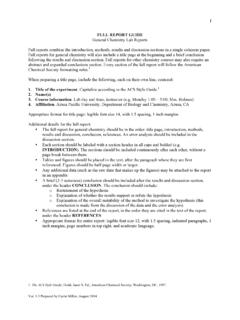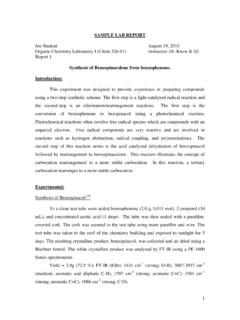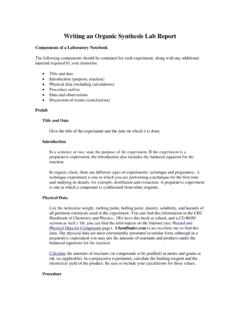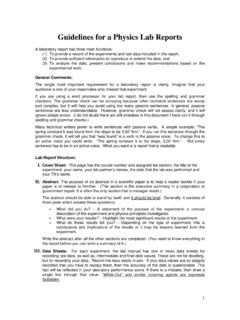Transcription of Lab Report Example - Sample Templates
1 AN Example Report by Cecil Dybowski, Here you list all names of people involved, along with email addresses. CHEMISTRY 446 Here you enter the section and group numbers. EXPERIMENT 6 Here you insert the date that the Report is submitted. Executive Summary The general format of a laboratory Report is explained and illustrated. Each section is illustrated. Common errors and problems are discussed. Data analogous to those of experiment 6 are used to demonstrate a typical Report structure. [NOTE: THE EXECUTIVE SUMMARY SHOULD ALWAYS BE THE LAST SECTION ONE WRITES. IT IS A SUMMARY, WHICH CANNOT BE DONE UNTIL ALL OF THE WORK OF THE EXPERIMENT AND THE WRITING OF OTHER SECTIONS IS FINISHED.] The title information and Executive Summary should not exceed one page. Text in blue font indicates text that is part of the Report .
2 Text is black is commentary on how to write the Report . Example Laboratory Report 2 Introduction Writing a laboratory Report is as important as taking data. When I say writing, that includes the careful analysis of data and attention to the details of how the information is formatted for the ultimate reader. Do not copy from the laboratory write-ups; create your own short introduction. The introduction should be concise. It should explain the outlines of the experiment, what results have been determined, and salient points about the experiment. It should be about how your experiment worked, not some reprise of the general statements in the write-ups. Remember that an introduction tells the reader what he/she is going to be reading. Here is an Example of a concise introduction: The infrared (IR) spectrum of CO has been analyzed to determine the fundamental constants of the molecule.
3 The results can be expressed in terms of the rotation constant, Be, the rotation-vibration constant, e, and the vibrational frequency. By IR spectroscopy on ground state molecules, it is not possible to determine the zeroth-order vibrational frequency, so we Report the vibrational frequency, 002 ex . The results are consistent with data in the literature, within experimental error. The object of the introduction is to give the reader a sense of what you are doing, why you are doing it in the way you are doing the experiment, and what results you have determined. Since scientific results are considered to be independent of the observer, it is appropriate to state any differences between one s work and that of others. It may be appropriate to give numbers at this point (as well as in a section labeled Conclusions , but it is not always necessary.)
4 Experimental The section entitled Experimental generally contains information on the physical properties of the experiment, such as the type of instrumentation used, the variables controlled and those that are not controlled, and any unusual conditions. Here is an Example of a section of that type. The experiment was carried out with a Nicolet Fourier transform infrared (FTIR) spectrometer. The resolution of the spectrometer was set at 1 cm-1 for all spectra. The experiment involved the accumulation of background spectra which were subtracted from the spectra of the Sample to provide the response of the Sample . The detector was a nitrogen-cooled cadmium-telluride detector. Each experiment resulted from the average 64 transient responses coadded, with the background spectrum being the accumulation of 64 spectra without the Sample present.
5 The data were analyzed by Fourier transformation using the software of the instrument. The data were saved to disk, and were subsequently analyzed with a spreadsheet program, in this case, Microsoft EXCEL. The section need not be long, but it should include everything about the experimental setup that the author thinks is important. While the data are usually gathered with an infrared spectrometer, the data discussed below are taken from Noggle s a real Report , one would include such things as calibration of instruments and special features. In addition, in some cases it is appropriate to discuss features such as how well the temperature was controlled (if it was or if it was necessary), barometric pressure or other pertinent experimental details such as concentrations of solutions (with an indication of calculations).
6 Example Laboratory Report 3 Anything important in defining the experimental conditions should be stated. One should also Report safety concerns in this section. Results and Discussion To start this section one has to refer to data. I do not write an Example paragraph, but the student should be able to write out a simple explanation. In the case of the infrared spectrum, the data are the positions of absorptions read off the spectrum. In other experiments, there may not be a table of data. In some cases there may be plots of data. Note the format of a table. There is a title. Generally there is a heading for each column describing what is contained in the column (including the appropriate units), and there are entries below that. If you are using WORD or some similar word processing program, you may be able to format the table in different ways.
7 Don t get carried away with this sort of thing; the important thing is to convey to the reader as precisely as possible what the data are. Do not allow the word processor to split a table unless there are so many entries that is absolutely necessary. In writing each Report , you have to make judgments about what things to include in the text of the Report , sometimes original data, sometimes partially reduced data. Data must be accompanied by some estimate of the uncertainty. The exact form of the reported uncertainty depends on the data source. In this case, I assumed that the data were uncertain to 1 unit in the last reported digit. A difference, such as the second column, has a larger uncertainty by virtue of the rules for determining uncertainty. I show a footnote way and an in-line way; use only one.
8 TABLE 1. PARTIAL LIST OF LINE POSITIONS IN THE SPECTRUM OF 12C16O Line Position (cm-1)a Line Position Difference (cm-1)b J J 7 6 6 5 5 4 4 3 3 2 2 1 1 0 0 1 1 2 2 3 3 4 4 5 5 6 a The uncertainty in the line position is cm-1. b The uncertainty in the difference is cm-1. Determining Associated Quantum Numbers. [NOTE THAT I CREATED A HEADING FOR THIS SUBSECTION TO MAKE IT CLEAR TO THE READER THAT I AM DISCUSSING SOMETHING SPECIAL. I DID NOT NUMBER THE SUBSECTION. Sometimes there are special considerations of data reduction. You should explain these clearly and concisely in a section of the results and discussion, as shown below.] One Example Laboratory Report 4 difficulty in resolving the data in the vibration-rotation spectroscopy experiment is determining the quantum numbers associated with each transition.
9 For diatomic molecules, the J=0 J=0 transition is forbidden and will be absent from the spectrum. This makes the separation of the first transition of the R branch from the first transition of the P branch approximately twice the spacing of the other transitions (which are otherwise roughly equally spaced). Examination of the difference between the line positions (second column of Table I) reveals that the lines are not exactly equally spaced. In particular, the two transitions at cm-1 and cm-1 have a much wider separation than the others. It is reasonable to assign these two transitions to J=1 J =0 and J=0 J =1, one from the P branch and one from the R branch. Once that assignment is made, assigning J and J for each of the other transitions is straightforward, since each transition corresponds to the rd and fourth rows of Table 1.
10 Analyzing the Branches to Obtain Parameters. [NOTE THAT A NEW SUBSECTION IS STARTED BECAUSE THIS IS ANOTHER PHASE OF THE ANALYSIS.] The energies of transition are expected to follow equations (1), where m is either J or J , depending on the branch: )1()1()1()1(010010+ += ++= mmBmmBEmmBmmBEPR . (1) In this equation, the definitions of the parameters are as follows: Bn is the rotational constant for the vibrational state with quantum number n and 0 = e 2xe e. Expansion of the first of these equations gives equation (2), a second-order equation in m: 201010)()(mBBmBBER +++= . (2) A similar equation can be found by expanding the second equation. From a plot of ER versus m, one determines the values of B1, B0, and 0 from the best-fit coefficients. An EXCEL graph of the data is given in Figure 1, showing plots for the R and P branches.







